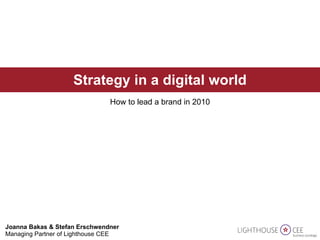
Strategy in a digital world
- 1. Joanna Bakas & Stefan Erschwendner Managing Partner of Lighthouse CEE Strategy in a digital world How to lead a brand in 2010
- 5. Blank – The power of blank http://www.youtube.com/watch?v=pPICpydTH6Q
- 13. Optimize media & networks
- 19. VW – GTI http://www.youtube.com/watch?v=RV_t29sX8-Y
- 24. old way integration Outdoor Print copy/paste existing content and messages without paying attention to the specific context and user behavior within channels
- 25. new way: transmedia storytelling the brand narrative or the brand story Connection and sharing Instant updates Surprise and entertain Visual story telling Detail Awareness Utilize the power of each specific channel so that users can experience messages and content that are tailored to their current environment
- 26. step 1: define your story Frank Striefler: How to create advocacy and conversations, http://www.slideshare.net/strieflerf/planningness-conference-draft1
- 27. step 2: share your story the brand narrative or the brand story Connection and sharing Instant updates Surprise and entertain Visual story telling Detail Awareness
- 28. Some transmedia examples http://mumbrella.com.au/birds-v-humans-in-ambitious-tooheys-5-seeds-cider-launch-10318 http://www.youtube.com/watch?v=XQcVllWpwGs - IN TV http://www.youtube.com/watch?v=TO4b2ZeVEaM&feature=channel - on YOUTUBE http://www.nytimes.com/2010/05/17/business/media/17salt.html?ref=technology
- 29. Nike – Write the story http://wklondon.typepad.com/welcome_to_optimism/
- 30. Nike – Write the story http://wklondon.typepad.com/welcome_to_optimism/
- 31. Nike – Write the story http://wklondon.typepad.com/welcome_to_optimism/
- 32. Nike – Write the story http://wklondon.typepad.com/welcome_to_optimism/
- 33. Nike – Write the story http://wklondon.typepad.com/welcome_to_optimism/
- 37. Burger King – Whopper Sacrifice http://www.youtube.com/watch?v=XXd0UoxK-Ik&feature=related
- 42. Square - Demo http://www.youtube.com/watch?v=QSzsFAJAKHI
- 48. Strategy today transfer best performing content into other kinds of offline media like TV & print
- 49. From big ideas to micro strategies transfer best performing content into other kinds of offline media like TV & print http://www.slideshare.net/Klawiklawaklawong/digital-strategy-a-deck-for-the-university-of-applied-sciences-siegen-3216472
- 52. About Lighthouse we believe that business opportunities come from an insight into the bigger picture and understanding consumers as people from a cultural and sociological perspective In short we are a a brand and business consultancy with offices in Copenhagen focusing on the Nordics and in Vienna where we focus on Central Eastern Europe. Our guiding principle is that as a brand and business consultancy, we believe that good strategies come from an overall understanding on society and people. We measure changing consumer behavior and evolving needs. This helps us better understand the business opportunities – WHITE SPACES. Based on identifying unmet needs and business opportunities, together with our clients we create and implement powerful business and brand ideas that create value.
- 53. What we do: Our model – Culture Tap CONTEXT measurement (strategy and opportunity spaces) Ideas that people are ready to embrace idea CREATION (content) Powerful concepts inspired by context opportunities consumer CONNECTION (implementation follow through) Getting it out there to market
- 54. Contact Joanna Bakas Managing Partner [email_address] +36 70 568 4849 Stefan Erschwendner Managing Partner [email_address] + 43 650 372 6486 Lighthouse CEE Rasumofskygasse 26 1030 Wien Austria Follow us on Twitter: http://www.twitter.com/LH_CEE
